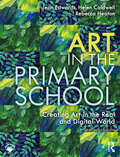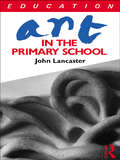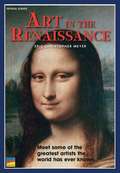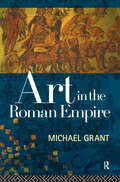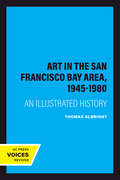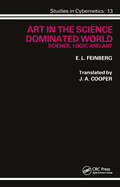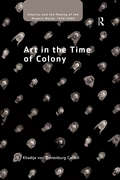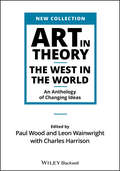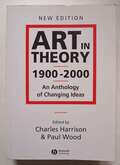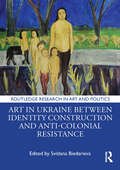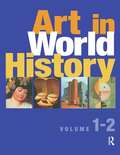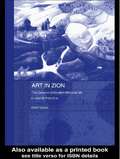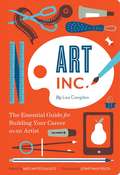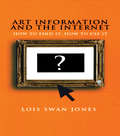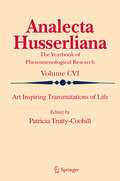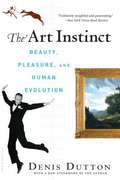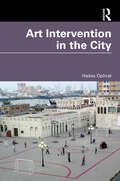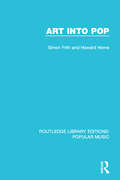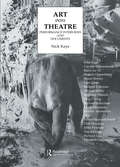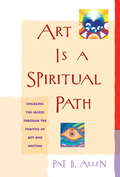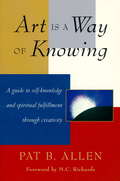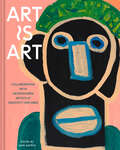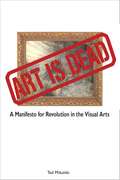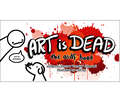- Table View
- List View
Art in the Primary School: Creating Art in the Real and Digital World
by Jean Edwards Helen Caldwell Rebecca HeatonArt in the Primary School is an introductory textbook, and a second edition to Teaching Primary Art, exploring the underpinning philosophy and pedagogy of teaching and learning art, including how and why digital tools and technologies can be integrated. This book considers practical aspects of teaching art, focusing on key processes of art making that children might experience in primary schools. It is based around the idea that digital tools and technologies can and should be integrated into the learning and teaching of art, exploring: What art is like in the primary school, why it should be taught and what is included in the curriculum How learning is planned, assessed, taught and supported in the classroom Learning about and from artists and how digital technology can be part of the art curriculum Key processes such as drawing, painting, printmaking, collage and textiles, working in three dimensions and making digital art Uniquely incorporating the use of digital devices, tools and technologies into the subject of art, this book will be essential reading for those training to teach and support learning in art in the primary school.
Art in the Primary School
by John LancasterArt has always been an important part of the primary school experience. It is now one of the foundation subjects in the National Curriculum. In this book, John Lancaster helps teachers rise to the challenge of art for young children. He encourages thought about the purpose of art teaching, and at the same time provides a wealth of project ideas and helpful advice on how to organize art, craft and design in the primary classroom. The book, fully illustrated with charts and black and white plates, gives practical advice on how to: define suitable objectives and plan lessons so as to achieve them make the best use of natural and man-made resources within and outside the classroom present children's work effectively by display throughout the school encourage aesthetic awareness and art knowledge by a study of the historical and cultural aspects Organise and benefit from visits to local art galleries approach assessment of children's art and craft activities This is a basic philosophical and practical guide which will give confidence to new teachers and fresh ideas to their more experienced colleagues.
Art in the Renaissance
by Eric Christopher MeyerFind out about the great sculptures and paintings that were created by artists and architects during the Renaissance.
Art in the Roman Empire
by Michael GrantMichael Grant has specially selected some of the most significant examples of painting, portraits, architecture, mosaic, jewellery and silverware, to give a unique insight into the functions and manifestations of art in the Roman Empire. Art in the Roman Empire shows how many of the most impressive masterpieces were produced outside Rome, on the frontiers of its enormous empire.
Art in the San Francisco Bay Area, 1945-1980: An Illustrated History
by Thomas AlbrightThis title is part of UC Press's Voices Revived program, which commemorates University of California Press’s mission to seek out and cultivate the brightest minds and give them voice, reach, and impact. Drawing on a backlist dating to 1893, Voices Revived makes high-quality, peer-reviewed scholarship accessible once again using print-on-demand technology. This title was originally published in 1985.This title is part of UC Press's Voices Revived program, which commemorates University of California Press’s mission to seek out and cultivate the brightest minds and give them voice, reach, and impact. Drawing on a backlist dating to 1893, Voices Revived</DIV
Art in the Science Dominated World: Science, Logic and Art
by E. L. FeinbergThe subject of cybernetics is quickly growing and there now exists a vast amount of information on all aspects of this broad-based set of disciplines. This book concerns the phenomenon of art and the special problems that arise concerning art in our era which is almost unanimously regarded as unique, as the era when science and technology have, as never before, become the influence on human society. The aim of this book is to consider the two ways of perception and cognition of the world, two kinds and trends of man’s spiritual life in their interrelation
Art in the Time of Colony (Empire and the Making of the Modern World, 1650-2000)
by Khadija von CarrollIt is often assumed that the verbal and visual languages of Indigenous people had little influence upon the classification of scientific, legal, and artistic objects in the metropolises and museums of nineteenth-century colonial powers. However colonized locals did more than merely collect material for interested colonizers. In developing the concept of anachronism for the analysis of colonial material this book writes the complex biographies for five key objects that exemplify, embody, and refract the tensions of nineteenth-century history. Through an analysis of particular language notations and drawings hidden in colonial documents and a reexamination of cross-cultural communication, the book writes biographies for five objects that exemplify the tensions of nineteenth-century history. The author also draws on fieldwork done in communities today, such as the group of Koorie women whose re-enactments of tradition illustrate the first chapter’s potted history of indigenous mediums and debates. The second case study explores British colonial history through the biography of the proclamation boards produced under George Arthur (1784-1854), Governor of British Honduras, Tasmania, British Columbia, and India. The third case study looks at the maps of the German explorer of indigenous taxonomy Wilhelm von Blandowski (1822-1878), and the fourth looks at a multi-authored encyclopaedia in which Blandowski had taken into account indigenous knowledge such as that in the work of Kwat-Kwat artist Yakaduna, whose hundreds of drawings (1862-1901) are the material basis for the fifth and final case study. Through these three characters’ histories Art in the Time of Colony demonstrates the political importance of material culture by using objects to revisit the much-contested nineteenth-century colonial period, in which the colonial nations as a cultural and legal-political system were brought into being.
Art in Theory: The West in the World - An Anthology of Changing Ideas
by Paul Wood Leon Wainwright Charles HarrisonArt in Theory: The West in the World is a ground-breaking anthology that comprehensively examines the relationship of Western art to the art and material culture of the wider world. Editors Paul Wood and Leon Wainwright have included over 350 texts, some of which appear in English for the first time. The anthologized texts are presented in eight chronological parts, which are then subdivided into key themes appropriate to each historical era. The majority of the texts are representations of changing ideas about the cultures of the world by European artists and intellectuals, but increasingly, as the modern period develops, and especially as colonialism is challenged, a variety of dissenting voices begin to claim their space, and a counter narrative to western hegemony develops. Over half the book is devoted to 20th and 21st century materials, though the book’s unique selling point is the way it relates the modern globalization of art to much longer cultural histories. As well as the anthologized material, Art in Theory: The West in the World contains: A general introduction discussing the scope of the collection Introductory essays to each of the eight parts, outlining the main themes in their historical contexts Individual introductions to each text, explaining how they relate to the wider theoretical and political currents of their time Intended for a wide audience, the book is essential reading for students on courses in art and art history. It will also be useful to specialists in the field of art history and readers with a general interest in the culture and politics of the modern world.
Art In Theory, 1900-2000: An Anthology Of Changing Ideas
by Charles Harrison Paul WoodThis popular anthology of twentieth-century art theoretical texts has now been expanded to take account of new research, and to include significant contributions to art theory from the 1990s. New edition of this popular anthology of twentieth-century art-theoretical texts. Now updated to include the results of new research, together with significant contributions from the 1990s. Includes writings by critics, philosophers, politicians and literary figures. The editors provide contextual introductions to 340 texts. Complements Art in Theory 1648-1815 and Art in Theory 1815-1900 to create a complete survey of the theories underpinning the development of art in the modern period.
Art in Ukraine Between Identity Construction and Anti-Colonial Resistance (Routledge Research in Art and Politics)
by Svitlana BiedarievaThis edited volume traces the development of art practices in Ukraine from the 2004 Orange Revolution, through the 2013–2014 Revolution of Dignity, to the ongoing Russian war of aggression.Contributors explore how transformations of identity, the emergence of participatory democracy, relevant changes to cultural institutions, and the realization of the necessity of decolonial release have influenced the focus and themes of contemporary art practices in Ukraine. The chapters analyze such important topics as the postcolonial retrieval of the past, the deconstruction of post-Soviet visualities, representations of violence and atrocities in the ongoing Russian war against Ukraine, and the notion of art as a mechanism of civic resistance and identity-building.The book will be of interest to scholars of art history, Eastern European studies, cultural studies, decolonial studies, and postcolonial studies.
Art in World History 2 Vols
by HollingsworthA guide to the establishment of the library which covers materials acquisition, the organization and usage of the library's collection to provide a variety of services and the use of automation. This book aims to instruct the librarian on managing the small library effectively.
Art in Zion: The Genesis of Modern National Art in Jewish Palestine (Routledge Jewish Studies Series)
by Dalia ManorArt in Zion deals with the link between art and national ideology and specifically between the artistic activity that emerged in Jewish Palestine in the first decades of the twentieth century and the Zionist movement. In order to examine the development of national art in Jewish Palestine, the book focuses on direct and indirect expressions of Zionist ideology in the artistic activity in the yishuv (the Jewish community in Palestine). In particular, the book explores two major phases in the early development of Jewish art in Palestine: the activity of the Bezalel School of Art and Crafts, and the emergence during the 1920s of a group of artists known as the Modernists.
Art, Inc.
by Jonathan Fields Meg Mateo Ilasco Lisa CongdonArtists who dream of turning their passion into a career need only the expert guidance in Art, Inc. Lisa Congdon unveils the multiplicity of ways to make a living from art--including illustration, licensing, fine art sales, print sales, and teaching-- and offers practical advice on cultivating a business mindset, selling and promoting work, and more. Trade secrets from art world pros including such luminaries as Paula Scher, Nikki McClure, and Mark Hearld make Art, Inc. the ultimate resource for aspiring artists ready for success.
Art Information and the Internet: How to Find it, How to Use It (How To Find It, How To Use It Ser.)
by Lois Swan JonesIn the first book of its kind, art information expert Lois Swan Jones discusses how to locate visual and textual information on the Internet and how to evaluate and supplement that information with material from other formats--print sources, CD-ROMS, documentary videos, and microfiche sets--to produce excellent research results. The book is divided into three sections: Basic Information Formats; Types of Websites and How to Find Them; and How to Use Web Information. Jones discusses the strengths and limitations of Websites; scholarly and basic information resources are noted; and search strategies for finding pertinent Websites are included. Art Information and the Internet also discusses research methodology for studying art-historical styles, artists working in various media, individual works of art, and non-Western cultures--as well as art education, writing about art, problems of copyright, and issues concerning the buying and selling of art. This title will be periodically updated.
Art Inspiring Transmutations of Life (Analecta Husserliana #106)
by Patricia Trutty CoohillAlthough the creative impulse surges in revolt against everyday reality, breaking through its confines, it makes pacts with that reality's essential laws and returns to it to modulate its sense. In fact, it is through praxis that imagination and artistic inventiveness transmute the vital concerns of life, giving them human measure. But at the same time art's inspiration imbues life with aesthetic sense, which lifts human experience to the spiritual. Within these two perspectives art launches messages of specifically human inner propulsions, strivings, ideals, nostalgia, yearnings prosaic and poetic, profane and sacral, practical and ideal, while standing at the fragile borderline of everydayness and imaginative adventure. Art's creative perduring constructs are intentional marks of the aesthetic significance attributed to the flux of human life and reflect the human quest for repose. They mediate communication and participation in spirit and sustain the relative continuity of culture and history.
The Art Instinct: Beauty, Pleasure, & Human Evolution
by Denis DuttonThe Art Instinct combines two of the most fascinating and contentious disciplines, art and evolutionary science, in a provocative new work that will revolutionize the way art itself is perceived. Aesthetic taste, argues Denis Dutton, is an evolutionary trait, and is shaped by natural selection. It's not, as almost all contemporary art criticism and academic theory would have it, "socially constructed.
Art Intervention in the City
by Hadas OphratThis book focuses on the phenomenon of art intervention—an expression of local initiatives by artists, collectives, and art centers wishing to influence the design of the space or make a change in its lifestyle. It pertains not only to acts of protest, but also to the creation of a new civil and political situation in which artists acknowledge their ability to constitute foci of power. These are reflected in acts such as squatting in abandoned buildings, restoring and redistributing them according to principles of social justice; mapping the city based on alternative parameters, such as revealing venues of collective memory or exposing the city's backyard; creating outdoor urban art galleries; and creating temporary architecture and alternative solutions in order to deal with the challenges we face in times of epidemic and environmental crisis. The art intervention phenomenon has intensified since the mid-1990s, so much so that even local authorities the world over have begun to adopt activist and artistic practices. Due to the intensive urbanization processes and current global threats, the creative trends and means surveyed in the book are crucial. This book will interest researchers, planners, urban planners, architects, social activists, local authority executives, art centers, artists, and designers.
Art Into Pop (Routledge Library Editions: Popular Music #2)
by Simon Frith Howard HorneThis book, first published in 1987, tells the intriguing and culturally complex story of the art school influence on postwar British popular music. Following Romantic attitudes from life class to recording studio, it focuses on two key moments – the early 1960s, when art students like John Lennon and Eric Clapton begin to play their own versions of American rock and blues and inflected youth music with Bohemian dreams, and the late 1970s, when punk musicians emerged from design courses and fashion departments to disrupt what were, by then, art-rock routines. Sixties rock Bohemians and seventies pop Situationists were, in their different ways, trying to solve the art students’ perennial problem – how to make a living from their art. Art Into Pop shows how this problem has been shaped by the history of British art education, from its nineteenth-century origins to current arguments about ‘pure’ and ‘applied’ training. In their simultaneous pursuit of authenticity and artifice, art school musicians exemplify the postmodern condition, the collapse of any distinction between ‘high’ and ‘low’ culture, the confusions of personal and commercial creativity. And so high pop theorists rub shoulders here with low pop practitioners, experimental musicians debate avant-garde ideas with corporate packagers, and artistic integrity becomes a matter of making oneself up.
Art Into Theatre: Performance Interviews and Documents (Contemporary Theatre Studies #Vol. 16.)
by Nick KayeArt Into Theatre investigates the processes of hybrid forms of performance developed between 1952 and 1994 through a series of interviews with key practitioners and over 80 pieces of documentation, many previously unpublished, of the works under discussion.Ranging from the austerity of Cage's 4'33" through the inter-species communication of Schneeman's Cat Scanand the experimental theatre work of Schechner, Foreman, and Kirby, to the recent performances of Abramovic, Forced Entertainment and the Wooster Group, Art Into Theatre offers a fascinating collection of perspectives on the destabilizing of conventional ideas of the art "object" and the theatrical "text". Nick Kaye's introductory essay to the volume offers a useful context for the reader and each interview is preceded by an informative biographical sketch.
Art Is a Spiritual Path
by Pat B. AllenArt is a spiritual path--not a religion, but a practice that helps us knit together the ideals and convictions that guide our lives. Creating art can be prayer, ritual, and remembrance of the Divine. And the sharing of this creativity with others in small groups can serve as sanctuary, asylum, ashram, therapy group, think tank, and village square. Pat Allen has developed a reliable guide for walking the path of art through a series of simple practices that combine drawing, painting, and sculpture with journal writing. Designed for readers at any level of artistic experience, the book shows how to: * awaken the creative force and connect with the divine source of creativity * access inner wisdom and intuition about life issues, including both personal and community concerns * find a path to meaning that includes honoring, celebrating, and giving thanks * explore the images and symbols of traditions such as Catholicism, Judaism, shamanism, and Goddess worship * join in spiritual community with others who are following the path of art * discover that artmaking can help us live our ideals and be of service in the world Detailed examples from the author's own practice of art, plus the stories and images of several other people, are presented to illustrate how art becomes a spiritual path in action. At the author's virtual studio, www.patballen.com, readers can post their images and writings, communicate with the author, and subscribe to an electronic newsletter. The site also contains an archive of the images in this book in full color.
Art Is a Way of Knowing: A Guide to Self-Knowledge and Spiritual Fulfillment through Creativity
by Pat AllenMaking art--giving form to the images that arise in our mind's eye, our dreams, and our everyday lives--is a form of spiritual practice through which knowledge of ourselves can ripen into wisdom. This book offers encouragement for everyone to explore art making in this spirit of self-discovery--plus practical instructions on material, methods, and activities such as ways to: * Discover a personal myth or story * Recognize patterns and themes in one's life * Identify and release painful memories * Combine journaling and image making * Practice the ancient skill of active imagination * Connect with others through sharing one's art works Interwoven with this guidance is the intimate story of the author's own journey as a student, art therapist, teacher, wife, mother, and artist--and, most of all, as a woman who discovered a profound and healing connection with her soul through making art." Pat B. Allen Ph.D., ATR, is an artist and a registered art therapist who teaches at the School of the Art Institute of Chicago. She produces workshops, events, and collaborative projects around the country and directs an online image community at www.patballen.com, where readers can post their images and writings, communicate with the author and one another, and subscribe to an electronic newsletter. ""Allen has produced a wonderful book for anyone, artistic or not, who is interested in using art to know more about himself or herself."--Elizabeth Caulfield Felt, Washington State University, Pullman, Library Journal "Art Is A Way of Knowing has a practical, hands on, and experiential feel to it. It is like a guide book or a manual for those interested in self-exploration through creative activity. Allen persistently invites the reader to join her. I found her to be an encouraging and competent guide."--American Journal of Art Therapy "Finally, a self-help book that is true to the passionate and turbulent movements of the soul in the process of creation."--Shaun McNiff, Ph.D., author of Art as Medicine
Art Is Art: 40 Years of Collaborating with Neurodiverse Artists at Creativity Explored
by Ann KappesCreativity Explored celebrates its 40th anniversary with a collection of powerful artwork and perspectives from its talented studio artists.This vibrant book uplifts the voices of the artists of Creativity Explored, a nonprofit that gives people with developmental disabilities the opportunity to express themselves through art and share their work with audiences from their local community and in the contemporary art world.This curated collection features more than one hundred original paintings, drawings, illustrations, and sculptures—as well as quotes and stories from the artists—inviting readers to examine and challenge their perceptions about disability. Some artworks are humorous and blunt, while others are affecting and abstract, speaking to the artistic community's diversity and creativity. This book offers an engaging introduction to person-centered thinking for art lovers or anyone interested in learning about disability justice in a visual way.DEMYSTIFYING DISABILITY: This significant new anthology showcases an array of developmentally disabled artists and organizes their works into thematic chapters, such as "Self Medication," "On the Spectrum," "Yes I Do Think About Sex," and "Our Fears." These chapters provide interesting stylistic juxtapositions and personal reflections that highlight both individual and shared experiences as diverse disabled artists. BEAUTIFUL AND CONTENT RICH: This gorgeous hardcover art book features more than one hundred original artworks in full color, from lively portraits and detailed drawings to abstract paintings and captivating illustrations. Quotes, interviews, personal stories, and artist statements also give readers deeper insight into the artists' creative practices, processes, and rituals. This book is a rich visual trove and source of inspiration for any contemporary art lover. SUPPORT A GREAT CAUSE: Creativity Explored was founded in 1983 with the belief that art is essential to life. This book celebrates the organization's mission and its talented artists after forty years of creating impactful arts and career programs with developmentally disabled artists. This collection is a meaningful way to learn more about Creativity Explored and the diverse community it continues to support today.Perfect for:Art lovers and activistsPeople who admire the mission and work of Creativity ExploredThe disabled community, allies, and educatorsGift seekers for family and friends interested in learning more about disability justiceFans of self-taught artists, folk arts, and "outsider art"Contemporary art anthology and art book collectors#OwnVoices readers and anyone interested in diversifying their contemporary art knowledge
Art Is Dead: A Manifesto for Revolution in the Visual Arts
by Ted MikulskiIf you were asked to name your favorite living visual artist what would you say? Unfortunately, the average American does not have an answer to that question, nor can they rationalize a piece of art beyond the Mona Lisa. Intriguing and entertaining, Art is Dead takes a profound look at visual art in America through the eyes of artist and art professor Ted Mikulski. This book steps outside of the conventional art bubble and rationalizes how we in America perceive both art and the artists creating it. Art Is Dead takes a stab at the question, why don?t Americans know more about art? Drawing on interviews with artists, gallery owners, curators, and those not involved in the art world, Mikulski takes the reader on a journey into visual arts current status in society. Artists will always be around, but are they revered? Are they appreciated? And more importantly, are they figureheads in society?
Art is Dead: the asdf book
by Thomas RidgewellIn 2008, Thomas "TomSka" Ridgewell uploaded a short animated film to YouTube; he called it asdfmovie. It has since been viewed more than 50 million times and has spawned eight sequels and many, many dedicated fans. Now, for the first time, the weird and wonderful world of asdf has exploded onto the page in ART IS DEAD, a book conceived and written by Tom and illustrated by Matt Ley. Featuring much-loved characters from the films, as well as brand-new, never-before-seen comics and bonus material - including the asdf origin story and Tom's own sketches - ART IS DEAD is a comic book like no other. Expect trains, potatoes, suicidal muffins and jokes about "death, destruction and things talking that don't normally talk", all wrapped up in book so awkwardly shaped it will make your shelves look weird. (Sorry about that.)
Art is Dead: the asdf book
by Thomas RidgewellIn 2008, Thomas "TomSka" Ridgewell uploaded a short animated film to YouTube; he called it asdfmovie. It has since been viewed more than 50 million times and has spawned eight sequels and many, many dedicated fans. Now, for the first time, the weird and wonderful world of asdf has exploded onto the page in ART IS DEAD, a book conceived and written by Tom and illustrated by Matt Ley. Featuring much-loved characters from the films, as well as brand-new, never-before-seen comics and bonus material - including the asdf origin story and Tom's own sketches - ART IS DEAD is a comic book like no other. Expect trains, potatoes, suicidal muffins and jokes about "death, destruction and things talking that don't normally talk", all wrapped up in book so awkwardly shaped it will make your shelves look weird. (Sorry about that.)
